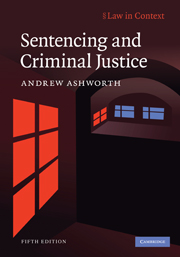Book contents
- Frontmatter
- Contents
- Preface
- Table of legislative measures
- Table of cases
- 1 An introduction to English sentencing
- 2 Sentencing and the constitution
- 3 Sentencing aims, principles and policies
- 4 Elements of proportionality
- 5 Aggravation and mitigation
- 6 Persistence, prevention and prediction
- 7 Equality before the law
- 8 Multiple offenders
- 9 Custodial sentencing
- 10 Non-custodial sentencing
- 11 Procedural issues and ancillary orders
- 12 Special sentencing powers
- 13 Conclusions
- Appendix: The Sentencing Council: provisions in the Coroners and Justice Act 2009
- References
- Index
10 - Non-custodial sentencing
Published online by Cambridge University Press: 05 June 2012
- Frontmatter
- Contents
- Preface
- Table of legislative measures
- Table of cases
- 1 An introduction to English sentencing
- 2 Sentencing and the constitution
- 3 Sentencing aims, principles and policies
- 4 Elements of proportionality
- 5 Aggravation and mitigation
- 6 Persistence, prevention and prediction
- 7 Equality before the law
- 8 Multiple offenders
- 9 Custodial sentencing
- 10 Non-custodial sentencing
- 11 Procedural issues and ancillary orders
- 12 Special sentencing powers
- 13 Conclusions
- Appendix: The Sentencing Council: provisions in the Coroners and Justice Act 2009
- References
- Index
Summary
In Chapter 9 the close connection between custodial and non-custodial sentencing was often evident, particularly when discussing the custody threshold. The present chapter aims to examine the principal non-custodial measures available to English courts when sentencing offenders aged 18 or over. The discussion begins with so-called ‘third tier’ sentences (absolute discharges, conditional discharges and bind-overs, compensation orders and fines), and then moves on to the community sentence, as reshaped by the Criminal Justice Act 2003. First, it is necessary to consider the route by which the English system arrived at its present position.
A brief history
Successive governments between the 1960s and the early 1990s stated a policy of reducing the use of custodial sentences, and regarded the provision of new forms of non-custodial sentence as a key element in this strategy. Community service orders (and compensation orders) formed part of the 1972 Criminal Justice Act. New forms of probation order were introduced by a Schedule to the 1982 Act, the Act which also legislated for curfew orders on young offenders. The result was that courts in England and Wales had available a wider range of non-custodial measures than the courts of most European countries, most states in the United States and probably most countries in the world. What might be described as the policy of proliferation was not a conspicuous success. Simply widening the range of available non-custodial sentences did little to deflect courts from their use of custodial sentences.
- Type
- Chapter
- Information
- Sentencing and Criminal Justice , pp. 318 - 357Publisher: Cambridge University PressPrint publication year: 2010

